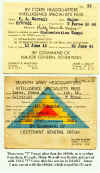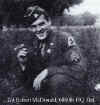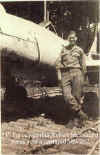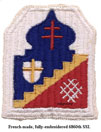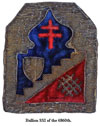|
insigne.org |
The 6860th Headquarters Detachment Intelligence Assault Force ("T" Force) by Les Hughes © 1997 by author |
|
|
The destiny of an intelligence unit comprising 52 men and disbanded over 50 years ago would seem to be certain obscurity. But that has proved not to be the case for the 6860th Headquarters Detachment Intelligence Assault Force ("T" Force), at least not among insignia collectors. Validating—in a strange way—the assertion that the pen is mightier than the sword, the inclusion of the shoulder sleeve insigne (SSI) of the 6860th and a sketch of the unit’s history in Richard W. Smith’s book on U.S. Army SSI of WWII propelled the unit and its SSI to prominence in the mind of many a collector [1]. Though brief, Smith’s history of the 6860th is surprisingly accurate given the fact it was based on the recollections of a single veteran of the unit. Why, then, more on this tiny organization? My aim here is to amplify what Smith presented and to correct a few minor points. Given the interest in the insignia of this unit, I have no doubt that there is an audience for this material. The Unit As the Allied armies pushed deeper into Italy, it appeared that Rome would be the first Axis capital to fall to the Allies. While it may have been just another city to the combat forces tasked with its capture and occupation, Rome represented an unusually rich prize for the Allied intelligence services. The problem confronting Allied planners was how best to absorb and handle the vast quantity of intelligence that the fall of Rome would lay at their feet, in light of the fact that the resources of the G-2 (Intelligence) Sections of the Divisions, Corps, and Army in whose zone of operations Rome fell would be fully engaged in supporting the execution of the tactical mission [2]. Contributing to the problem was the fact there were some twenty separate agencies—everyone from MI5 and the RAF to the CIC and the OSS—with interests in intelligence targets in Rome. To deal with the problem, a joint American-British special headquarters was organized by the direction of the Theater Commander, AFHQ, to operate under the direct control of the A. C. of S., G-2 Section, AFHQ. "S" Force Headquarters, as the new organization was designated, assumed the responsibility for research, preparation of target dossiers, and the formulation of a plan for seizing the intelligence targets and guarding the captured assets until they could be passed along to the appropriate agencies [3]. After months of planning, "S" Force personnel entered Rome on the day the city fell, 5 June 1944, and for a period of about ten days they carried out the organization’s plan of action. The effectiveness of "S" Force was so encouraging that the decision was made to operate along the same general lines in the future by using Intelligence Assault Forces in other large cities as they fell. The designation "T" Force ("T" for target) became synonymous with Intelligence Assault Force. The lessons learned by "S" Force were applied in Southern France after Operation Dragoon. A number of 7th Army personnel who had served with "S" Force, along with personnel from the First French Army, formed a "T" Force that operated in the South of France, targeting cities as they fell in the wake of the invasion. The Americans of this "T" Force would form the nucleus of the 6860th Headquarters Detachment. With the impending entry of Allied forces into Germany, it was anticipated that the number of targets of intelligence importance would escalate tremendously. The system that began with "S" Force broadened considerably, and "T" Forces became a part of the G-2 Sections of Army Groups, Armies, and Divisions. Hence, there was no single, unique "T" Force. In what follows, I shall focus exclusively on 6th Army Group’s "T" Force, which operated in conjunction with elements of the 7th Army and which became the 6860th. On 27 July 1944, General Eisenhower issued SHAEF Intelligence Directive 17 instructing 6th and 12th Army Groups to establish "T" Forces. Amplification of the Directive was provided in a memorandum from SHAEF Forward Headquarters dated September 1944. On 12 October 1944, 6th Army Group requested a specific allocation of personnel for the purpose of forming a "T" Force. Anticipating that the request would be approved, 6th Army Group proceeded to establish a provisional "T" Force using personnel from its Number 2, Intelligence Collection Unit. The Headquarters of the provisional Force was the Chateau de Condes, near Chaumont. "T" Force’s task was to identify the intelligence assets of a target city and to establish a plan for capturing and holding the assets. It was not "T" Force’s mission to analyze the captured assets: that fell to others. Thus, prior to an operation, "T" Force base would experience an influx of intelligence specialists from the various agencies that were responsible for analyzing the captured intelligence assets and disseminating them to the appropriate agencies. "T" Force’s operation in Strasbourg, the first city targeted by the provisional Force, illustrated both the risks and the rewards that awaited Intelligence Assault Forces. The mission of Lt. James Lares on 22 November 1944 was simple enough: enter Strasbourg at the height of enemy resistance, make contact there with the infantry battalion assigned to support "T" Force, and establish "T" Force’s forward Command Post in the city. In order to reach Strasbourg, Lt. Lares had to drive through areas that the leading Allied infantry units had by-passed, thus bringing his jeep repeatedly under enemy small arms and machine gun fire. After reaching Strasbourg and establishing contact with the infantry battalion, Lt. Lares, despite heavy enemy sniper activity, proceeded to scout selected locations as a possible CP. Disregarding the advice of the infantry battalion’s commander to delay his return until day break, Lt. Lares, alone, retraced his route back to where the balance of "T" Force was poised to enter the city. The six-hour trip, punctuated again by enemy small arms and machine gun fire, was interrupted at one point by two German soldiers who attempted to stop the jeep and capture its occupant. Lt. Lares killed the two Germans and continued his trip, reaching "T" Force’s CP in time to pass along his first-hand assessment of the situation in Strasbourg as it affected "T" Force’s mission. For his actions that day, Lt. Lares received the Silver Star Medal. Around midnight of that evening, at about the time Lt. Lares returned from Strasbourg, delayed action mines began exploding in the vicinity of the unit’s Command Post in the village of Saarbourg, and soon thereafter enemy artillery zeroed in on the motor pool and the CP itself. When the dust settled, five men were dead and three were wounded. In part because of his coolness under fire and clear-headed decision making that night, one of the unit’s non-coms, Sgt. Charles Penn, was awarded a battlefield promotion to lieutenant. "T" Force entered Strasbourg on the following day, 23 November 1944, while the city was still being cleared of enemy, and began implementing its plan. The speed with which the city was overrun caught the Germans completely off guard—the tape in the telecrypter machine was still running when elements of "T" Force entered Gestapo Headquarters. In addition to capturing Gestapo files and a trove of other valuable intelligence, elements of "T" Force captured the plans for the first jet aircraft engine, as well as one of the prototype engines itself, at the Matford SA Junkers 88 plant. The success of the operation exceeded all expectations. "T" Force ceased to be Provisional on 31 November 1944 when SHAEF instructed 6th Army Group to establish "T" Force as a non-Table of Organization unit with an ETOUSA designation, and to assign the unit to Special Troops, 6th Army Group. On 9 February 1945, Headquarters, 6th Army Group, established the 6860th Headquarters Detachment Intelligence Assault Force ("T" Force), authorizing the unit the requested allocation of 9 officers and 43 enlisted personnel. Effectively, the order of 9 February simply redesignated "T" Force the 6860th Headquarters Detachment—i.e., all "T" Force personnel, including the Commanding Officer, Lt. Col. J. W. Pumpelly, retained their roles in the ‘new’ unit. The operations in Strasbourg constituted Phase 1 of a 4-phase plan for the 6860th. Phase 2 included operations in Frankenthal-Ludwigshafen, Mannheim, Heidelburg, Karlsruhe, and Wurzburg; Phase 3 targeted Stuttgart, Munich, and Berchtesgaden; Phase 4 included Augsburg, Ulm, and special assignments. As the Allies moved into Germany, 6th Army Group’s "T" Section moved its headquarters, first to Kaiserslautern and then, in April 1944, to Heidelberg, which had been identified as a dispersal center for important German industrial documents and personnel. In particular, it was in Heidelberg that the documents and personnel of Brown Bovari and Company and I. G. Farben—both important intelligence targets—were discovered. To deal with the documents of these and other targets, a Document Center was established in the library of the University of Heidelberg. Documents were copied at the Center and the copies disseminated to various intelligence agencies, including those dealing with war crimes. When the Center was closed, much of the captured material in its possession was shipped to the United States, where limited exploitation of the documents was performed by the Pentagon’s German Military Documents Section. Eventually, the original documents were returned to the German Government, and microfilm copies of many were retained in the National Archives, where they are available to researchers [4]. On 4 May 1945, in order to conveniently access targets in the south and east of Germany, "T" Force established its headquarters in a suburb of Munich. Operating in this region, "T" Force personnel accompanied troops of the 42d and 45th Divisions as they liberated the Dachau Concentration Camp. From an intelligence perspective, the real payoff came when elements of 7th Army entered the Alpine region of Germany, the Nazi redoubt, where "T" Force personnel found literally tons of valuable documents, some hidden in caves, others sunk to the bottom of deep lakes in special containers [4]. It had always been recognized that, from an intelligence perspective, Berlin was a prime target. A parachute operation was planned for Berlin, and "T" Forces, which had been provided with targets in the city, were to jump as part of the operation. When the Allies agreed to allow the Russians to enter Berlin first, the parachute operation was canceled and the "T" Forces became part of an Allied ground force that the Soviets kept sitting at Helmstedt for days before being allowed into the city. To the pleasant surprise of the Americans, the prime intelligence targets in Berlin were untouched, including the Patent Office, to which the Americans swiftly dispatched microfilm teams [5]. The Russians, it appeared, had nothing equivalent to the "T" Forces. (As the Allies moved into Germany, increasingly targets were selected because they provided intelligence on the Soviet Union. Map depots, for example, were of great interest as targets, as German forces had thrust deeply into Mother Russia and would be expected to have compiled up-to-date maps of the territory. Lt. Gen. (then Colonel) Andrew J. Boyle, who had overall command of SHAEF’s "T" Force activities, readily concedes that targeting assets because of their Russian implications was driven by the British, whose intelligence services were more foresighted than our own [5].) By 3 June 1945, the first three Phases of "T" Force’s Plan were completed. It is unclear from the record whether Phase 4 was undertaken. Neither do the records that I have located reflect when the 6860th ceased to exist. However, "T" Force operations continued after the war with an organization called FIAT [5]. The U.S. Government decided to exploit Nazi Germany’s scientific, technical, and industrial knowledge, and FIAT was given the task of combing Germany and gathering the targeted information. Mobile FIAT microfilm teams were sent to major plants and industrial facilities to copy material that had been identified as valuable by American technical and scientific experts assigned to work with FIAT. As it had been with "T" Force, so, too, many of FIAT’s targets were human. In addition to seeking those suspected of war crimes, FIAT, using catalogued lists of thousands of German scientists, technicians, and industrialists, targeted individuals with specialized skills. Eventually, about 1,000 Germans—including many from Germany’s rocket and nuclear programs—were recruited for work in the United States. The Insignia The design of the insignia of the 6860th, created by one of the unit’s officers, Major Miguel Montesinos, employs symbolism representing the various organizations with which "T" Force and its predecessor "S" Force worked: the 5th and 7th U.S. Armies, the French First Army, the British Eighth Army, and the U.S. 6th Army Group. The patches and the DI's were procured at the same time from the firm of A. Augis, a well-known French manufacturer of emblems and badges. Located in Lyon—about 150 miles south of the Chateau de Condes—Augis produced insignia from before the war until 1970. As the Allied forces of Overlord and Dragoon linked at Dijon, about 100 miles north of Lyon, on 12 September 1944, one may surmise that Augis was open to Allied business from about that date onward. (On the back of Lt. Lares's "T" Force ID card, illustrated above, is what appears to be a list of five officers, majors and colonels, and the notation that each contributed $10 for "patch & pin." It is unclear whether this was payment for their insignia alone or payment for the entire procurement.) It is the recollection of Robert McDonald, who joined "T" Force in Southern France and remained with the unit to the end of the war, that the insignia of the 6860th—both SSI and DI’s—were issued while the unit was based at the Chateau de Condes, which dates the distribution to October 1944 at the earliest [6]. Each member of the unit received three DI’s and four SSI. Three of the four SSI were machine-made and fully-embroidered. McDonald describes the fourth SSI as a "dress patch" with metallic threads. One may estimate the total number of "T" Force insignia to be no more than about 300 SSI and 200 DI’s. Given these numbers, one can make a good case for the insignia of the 6860th being rare (for comparison, 440 Alamo Scouts SSI were made). But rarity alone is not enough to generate the sort of interest one sees in these insignia: publicity is essential. And these insignia have gotten their fair share of publicity, and then some. It must be emphasized that all insignia were obtained in a single procurement. What this means in practical terms is that there exists a single legitimate version of the fully-embroidered sleeve patch and a single legitimate version of the bullion sleeve patch—legitimate in the sense of having been procured by the unit and distributed to its personnel. Variants of these patches other than the legitimate ones exist; some examples in bullion have sold for sums that are quite surprising when one considers their lack of provenance. (The eBay seller of one such bullion patch posed this question in his description: "...and of those 52 men [of the 6860th] how many had the rare bullion patch?" The answer is, each one of them! Though not the version he was offering.) I note in closing that I have seen offered for sale the triangular patch, with BATTLE AXE tab, of the 526th Armored Infantry Battalion, which was identified as the attack unit of "T" Force. The 526th did, in fact, play such a role, but for "T" Force of the 12th Army Group, not for the 6860th. Acknowledgments I would like to thank Serge Larcher for providing documents from the archives of A. Augis; Elliot Scimemi and James Lares for their generous support; and Robert McDonald, without whose encouragement and gentle prodding my research might never have been translated into this article. Footnotes 1. Smith, Richard W., Shoulder Sleeve Insignia of the U.S. Armed Forces 1941-1945, published by author, 1981. 2. The bulk of the information presented in this article is drawn from documents in The National Archives. 3. Jack Hochwald, who served in the 6860th, attributes the "T" Force concept to the Military Intelligence Research Section, a joint British/American agency formed in May 1943 for the purpose of formulating strategy and tactics to effectively capture and exploit intelligence targets once the invasion of occupied Europe began. 4. Hochwald, Jack, "The U.S. Army T-Forces: Documenting the Holocaust," American Jewish History, Vol. LXX, No. 3, March 1981. 5. Conversations Between Lt. Gen. Andrew J. Boyle and Lt. Col. Frank Walton, Vol. 1. Senior Officer Debriefing Program, U.S. Army Military History Research Collection, Carlisle Barracks, Pennsylvania. 6. Robert McDonald, private communication. |


